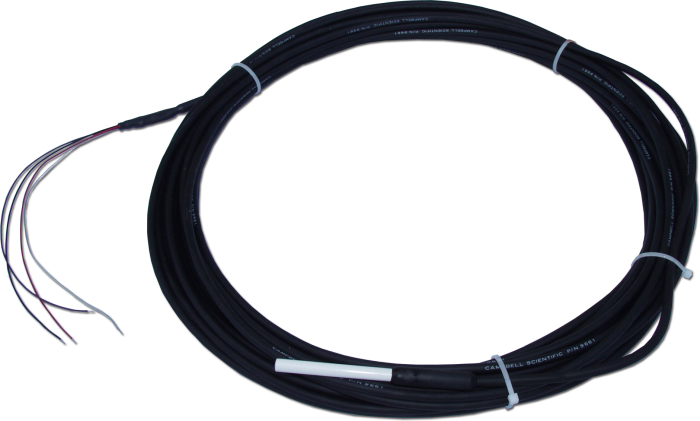
Can be used in a variety of applications






Overview
The 107 is a rugged, accurate probe that measures temperature of air, soil, or water from -35° to +50°C. It easily interfaces with most Campbell Scientific dataloggers and can be used in a variety of applications.
Read MoreBenefits and Features
- Versatile product—measures air, soil, or water temperature
- Easy to install or remove
- Durable
- Compatible with AM16/32-series multiplexers, allowing measurement of multiple sensors
Images



Detailed Description
The 107 consists of a thermistor encapsulated in an epoxy-filled aluminum housing. The housing protects the thermistor allowing the probe to be buried in soil or submerged in water.
Compatibility
Data Logger Considerations
One single-ended channel per probe is required; an excitation channel can be shared by several probes.
Installation Considerations
Air Temperature
When exposed to sunlight, the 107 should be housed in a 41303-5A, 41303-5B, or RAD06 6-plate radiation shield. The louvered construction of these radiation shields allows air to pass freely through the shield, thereby keeping the sensor at or near ambient temperature. The shields’ white color reflects solar radiation.
The RAD06 uses a double-louvered design that offers improved sensor protection from driving rain, snow, insect intrusion and has lower self-heating in bright sunlight combined with higher temperatures (> 24°C [~75°F]) and low wind speeds (< 2 m/s [~4.5 mph]), giving a better measurement.
The 41303-5A and RAD06 attach to a crossarm, mast, or usersupplied pipe with a 2.5 to 5.3 cm (1.0 in to 2.1 in.) outer diameter. The 41303-5B attaches to a CM500-series pole or a user-supplied pole with a 5.1 cm (2.4 in.) outer diameter.
Soil Temperature
The 107 is suitable for shallow burial only. Placement of the sensor’s cable inside a rugged conduit may be advisable for long cable runs—especially in locations subject to digging, mowing, traffic, use of power tools, or lightning strikes.
Water Temperature
The sensor can be submerged to 15 m (50 ft) or 21 psi. Please note that the 107 is not weighted. Therefore, the installer should either add a weighting system or secure the sensor to a fixed, submerged object, such as a piling.
Multiplexers
To measure large numbers of probes, the AM16/32B multiplexer is recommended.
Specifications
| Sensor Description | BetaTherm 100K6A1IA Thermistor |
| Tolerance | ±0.2°C (over 0° to 50°C range) |
| Temperature Measurement Range | -35° to +50°C |
| Temperature Survival Range | -50° to +100°C |
| Steinhart-Hart Equation Error | ≤±0.01°C over measurement range (CRBasic data loggers only) |
| Polynomial Linearization Error | Typically < ±0.5°C over measurement range (Edlog data loggers only) |
| Time Constant in Air | 30 to 60 s (in a wind speed of 5 m s-1) |
| Maximum Submergence | 15 m (50 ft) |
| Probe Diameter | 0.76 cm (0.3 in.) |
| Probe Length | 10.4 cm (4.1 in.) |
| Maximum Cable Length |
|
| Weight | 136 g (5 oz) with (3.05 m) 10 ft cable |
Documents
Product Brochures
Manuals
Casos de estudio
Overview As part of the United Nations Development Programme's (UNDP) Climate Adaptation Water and Energy Programme......read more
The Delaware Environmental Observing System (DEOS) is a real-time system dedicated to monitoring environmental conditions......read more
The West Texas Mesonet (WTM) project was initiated by Texas Tech University in 1999 to......read more
High-grade coal has been mined on the West Coast of New Zealand since the 1870s.......read more
The Mount Washington Observatory in New Hampshire is one of the oldest weather observatories in......read more
Acid Rock Drainage (ARD) problems associated with hard rock metal mining are one of the......read more
Successful aquaculture ultimately hinges on concentrations of dissolved oxygen. Measurement of DO is the single......read more





